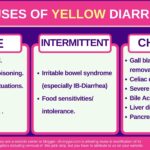Excess Bile in Stool: Causes and Symptoms.
Our content is not intended nor recommended as a substitute for medical advice by your doctor. Use for informational purposes only.
Bile is the end product of Hemoglobin (found in red blood cells). The breakdown of RBCs (red blood cells) leads to the formation of bile inside the liver.
Bile acids are formed inside the liver and secreted through bile into your intestine. They help digest and absorb fats and fat-soluble vitamins (vitamins A, D, E, and K).
Typically, 95% of bile acids inside your intestine are reabsorbed into the blood, and only 5% are excreted with stool.
Bile is chemically transformed into a brownish compound inside the gut, giving the stool its unique color.
MORE: What Do Gallstones Look Like in poop & toilet?
There are two leading causes of excess bile in stool:
- Bile acid malabsorption (BAM): primary or secondary defect in the flow back of bile from the intestine into the blood leading to excess bile acids in the stool.
- Severe diarrhea: extreme cases of diarrhea lead to the passage of bile from the intestine unchanged (because they have not enough time), leading to greenish stool.
1. Bile acid malabsorption (BAM) or bile acid diarrhea (BAD).
Bile acid diarrhea (BAD) is one of the most underrated causes of chronic diarrhea. Also, They are the leading cause of excess bile in stool.
Usually, your small intestine reabsorbs more than 95% of bile excreted from the liver through the gallbladder and bile duct (reference).
Excess bile acid secretion for any cause or decrease
How common is bile acid diarrhea?
Bile acid diarrhea is more common than you think. And it is often misdiagnosed as IBS-D.
The following facts and statistics will help you imagine the amplitude of BAD:
- About 25 to 50% of patients diagnosed with IBS-diarrhea have BAD (reference).
- It is estimated that about 1% of the population may have BAD.
- It is estimated that about 64% of patients with Functional diarrhea have BAD (reference).
- Up to 35% of people with a condition called “microscopic colitis” have BAD (reference).
Symptoms suggestive of Bile acid diarrhea:
- Constant diarrhea (especially after fatty meals).
- Extreme urgency: a sudden severe urge to poop.
- The extreme urgency may lead to soiling accidents (stool incontinence) in some people.
- Unlike IBS, diarrhea can occur at night (awakens you from sleep).
- Abdominal pain and stomach gurgling after meals.
- Bloating and flatulence.
Many doctors overlook bile acid. This is due to the relative unavailability of its specific test (SeHCAT test) and the similarity of symptoms with IBS.
The treatment of bile acid diarrhea is a bile acid binder called cholestyramine (Questran). We discussed the issue of BAD and its relation to IBS-D in-depth HERE.
2. Severe attacks of diarrhea.
Severe diarrhea for any cause (commonly infections) leads to rapid transit of unabsorbed bile through your gut. This leads to excess bile in the stool, which can turn green.
The most common cause of acute diarrhea is infection (especially viral infection). Diarrhea may start yellow and watery. If the condition is severe, the stool may turn green due to the excess bile in the stool.
The condition is often transient, and it resolves with the resolution of severe diarrhea.
Other than infections (gastroenteritis), excess bile in stool can be the result of:
- Severe Irritable bowel syndrome with diarrhea.
- Severe forms of food intolerance.
- Durg-induced severe diarrhea.
- Celiac disease.
- IBD.
- Any other causes of severe diarrhea.
MORE:
- Dark Green Poop: 6 Causes Explained.
- 5 Main Causes of Lack of Bile in Stool.
Does the pancreas Produce bile? & Why bilirubin is affected in pancreatic diseases.
- Evidence-based
- Written by a doctor.







